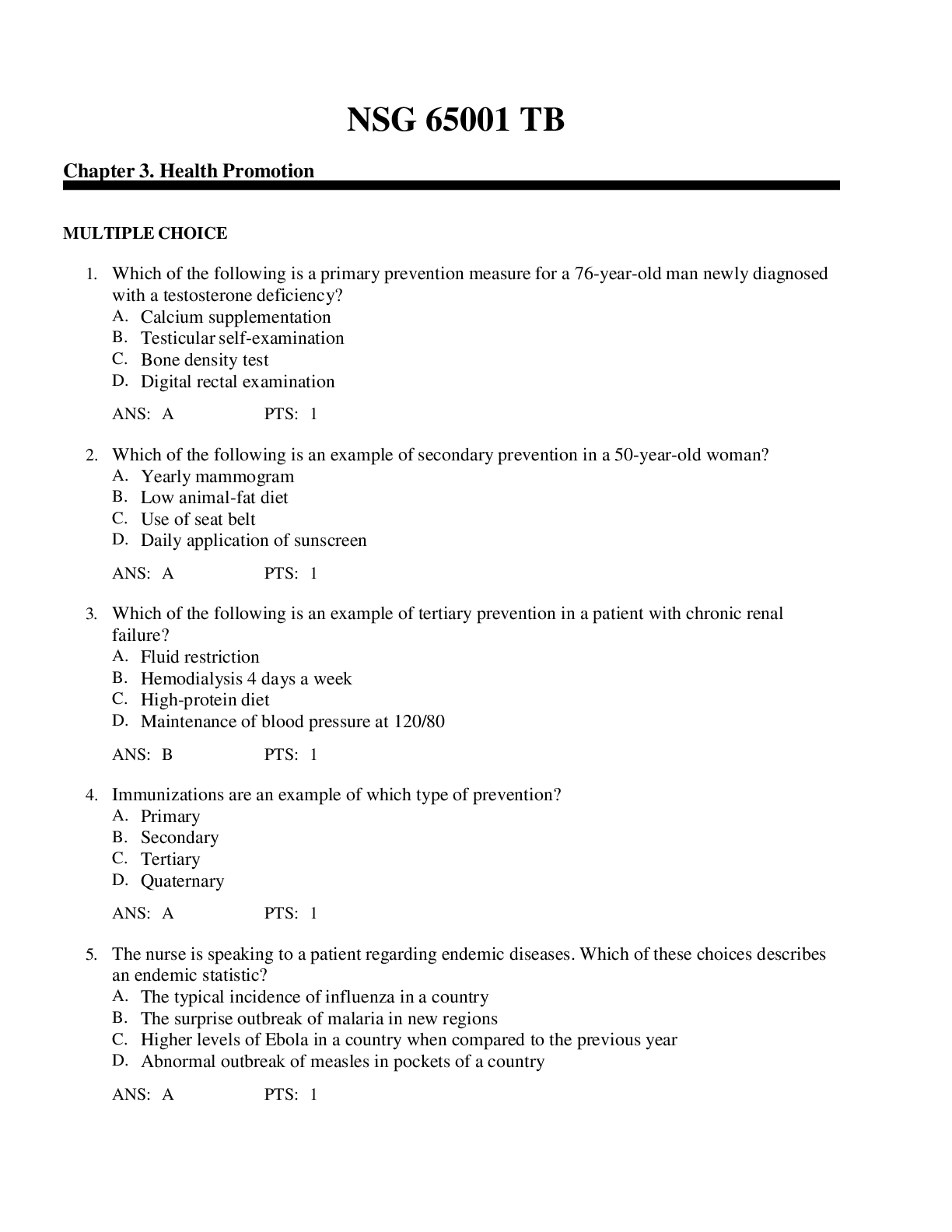*NURSING > EXAM > NSG 6001 ADVANCED NURSING PRACTICE SECTION 9. GENDER-RELATED HEALTH PROBLEMS (All)
NSG 6001 ADVANCED NURSING PRACTICE SECTION 9. GENDER-RELATED HEALTH PROBLEMS
Document Content and Description Below
NSG 6001 ADVANCED NURSING PRACTICE SECTION 9. GENDER-RELATED HEALTH PROBLEMS ADVANCED NURSING PRACTICE NSG 6001 Unit02_Section09 NSG 6001 / NSG6001 ADVANCED NURSING PRACTICE SECTION 9. GENDER-RELATE... D HEALTH PROBLEMS MULTIPLE CHOICE 1. Which of the following is a correct recommendation of when to begin prostate screening? A. Men with no symptoms of prostate cancer and who are in good health should start screening at age 60. B. Asian American men should start screening at age 45. C. Men who have had a brother diagnosed with prostate cancer before the age of 65 should start screening at 45. D. Caucasian men should start screening at age 55. 2. A 63-year-old man is seen in the clinic with a chief complaint of nocturia. Which of the following is the most common sign of a prostatic problems in men with nocturia? A. Psychogenic nocturia B. Urethral polyp C. Irritative posterior urethral lesion D. Benign prostatic hypertrophy 3. A 76-year-old man is seen in the office for complaints of urinary tract infection (UTI). The clinician should explore which of these causes of UTI in men? A. Urethral polyps B. Epididymitis C. Selective serotonin reuptake inhibitor (SSRI) medication D. Prostatodynia 4. A 14-year-old male is seen with complaints of severe testicular pain. The clinician suspects testicular torsion. Which of the following is the appropriate action? A. Refer to urologist immediately. B. Obtain a computed tomography (CT) scan. C. Instruct the patient to elevate the scrotum. D. Prescribe ibuprofen. 5. An 82-year-old man is seen in the primary-care office with complaints of dribbling urine and difficulty starting his stream. Which of the following should be included in the list of differential diagnoses? A. Prostatodynia B. Lupus disease C. Trichomoniasis infection D. Fungal infection 6. Which of the following would be an appropriate treatment for a patient with mild benign prostatic hyperplasia (BPH)? A. Referral to urologist for surgery. B. Prescribe a trial of tamsulosin. C. Recommend cranberry supplements. D. Have a period of watchful waiting. 7. A 30-year-old man is seen with a chief complaint of loss of libido. Which of the following laboratory tests would help establish a diagnosis? A. Testosterone level B. Prostate-specific antigen C. Nocturnal penile tumescence and rigidity D. Prolactin level 8. Peter is a 40-year-old male with a recent diagnosis of low testosterone. Which of the following counseling points is correct regarding low testosterone? A. Testosterone deficiency is due to hypergonadism. B. Abstaining from cigarette smoking has no effect on testosterone C. Lowering your HbA1c may improve your testosterone levels. D. Stress has no effect on testosterone levels. 9. Which of the following should be considered in a patient presenting with erectile dysfunction? A. Diabetes mellitus B. Hypotension C. Wellbutrin D. UTI 10. A 35-year-old man presents with complaints of painful erections, and he notices his penis is crooked when erect. What is the most likely diagnosis? A. Peyronie’s disease B. Damage to the pudendal artery C. Scarring of the urethra D. Testicular torsion 11. The patient with BPH is seen for follow-up. He has been taking finasteride (Proscar) for 6 months. The clinician should assess this patient for which of these side effects? A. Erectile dysfunction B. Glaucoma C. Hypotension D. Headache 12. Which of the following is an aerobic gram-negative bacteria involved in prostatitis? A. Streptococcus faecalis B. Pseudomonas C. Staphylococcus D. Diphtheroids 13. The 56-year-old man with chronic prostatitis should be treated with levofloxacin for how long? A. 3 to 7 days B. 14 to 21 days C. 4 to 6 weeks D. 6 to 12 weeks 14. John presents with complaints of a “weird feeling that hurts” in his buttocks. He notes that he often feels urgency to urinate and defecate, but “nothing comes out” when he tries. Which of the following diagnoses is most likely? A. Urinary tract infection B. Prostatitis C. Erectile dysfunction D. Peyronie’s disease 15. A 46-year-old man presents with urinary hesitancy and low back pain. He has no history of UTI. Digital rectal examination (DRE) reveals a normal prostate. He is not a long-distance runner. Which of the following would lead you to a diagnosis of prostatodynia versus prostatitis? A. Long-distance runners are more likely to have prostatodynia than prostatitis. B. Prostatodynia presents with signs and symptoms of prostatitis, but without inflammation. C. Prostatodynia usually has a bacterial origin, whereas prostatitis has a relation to internal urethral sphincter problems. D. Patients with prostatodynia usually have a history of recurrent UTIs, whereas patients with prostatitis do not. 16. A 23-year-old sexually active man is seen in the clinic with unilateral painful testicular swelling, and he is diagnosed with epididymitis. In order to prescribe the correct drug, the clinician must understand that which of these is the most common causative organism? A. Escherichia coli B. Staphylococcus aureus C. Chlamydia trachomatis D. Pseudomonas aeruginosa 17. Carl is a 24-year-old male who presents with scrotal pain that radiates to his flank. It manifested 3 hours ago. He also complains of pain at the tip of his penis, cloudy urine, and urethral discharge. Which of the following conditions is most likely? A. Testicular torsion B. Epididymitis C. Prostatodynia D. Prostatitis 18. Which test is used to confirm a diagnosis of epididymitis? A. Urinalysis B. Gram stain of urethral discharge C. Complete blood cell count with differential D. Ultrasound of the scrotum 19. Treatment for epididymitis includes which of the following? A. Warm sitz baths B. Scrotal elevation C. Masturbation D. Heat application 20. Which of the following data is indicative of testicular torsion? A. Absent cremasteric reflex B. Pain relieved on testicular elevation C. Testicle very low in the scrotum D. Swollen scrotum with “red dot sign” 21. A 60-year-old man presents with an enlarged scrotum. The clinician uses a penlight to transilluminate the scrotum. In a patient with a hydrocele, what would the clinician expect to find? A. The scrotum will be dark. B. The scrotum will appear light pink or yellow. C. The scrotum will appear milky white. D. The internal structures will be clearly visible. 22. During a DRE on a 75-year-old man, the clinician suspects the patient has prostate cancer. What physical finding should make the clinician suspicious? A. A nodular and unusually firm gland B. A smooth gland C. A tender gland D. A boggy gland 23. A patient presents complaining of pain and enlarged testes that feel like “a bag of worms.” Which diagnosis should the provider most likely assess for? A. Prostate cancer B. Varicocele C. Hydrocele D. Testicular cancer 24. Which of the following is a complementary therapy for BPH? A. Red raspberry leaf tea B. Saw palmetto C. Black cohosh D. Vitamin A 25. A 78-year-old man is diagnosed with C2 prostate cancer, and he asks the clinician what that means. In order to answer the patient, the clinician must have which understanding of the Jewett rating system? A. The cancer involves the seminal vesicles. B. There is metastatic disease to regional lymph nodes. C. The cancer is confined to the capsule. D. There is metastasis to distant organs. 26. A 58-year-old patient has been receiving leuprolide as treatment for prostate cancer. The clinician should instruct the patient about which of these side effects? A. May have cold flashes B. May have hot flushes C. May have increased libido D. May have testicular torsion 27. A 22-year-old male is seen in the clinic because he found a hard lump in his testicle when performing testicular self-examination (TSE). Which of the following risk factors leads the clinician to suspect potential testicular cancer? A. Patient is 65 years old B. Prior cryptorchidism C. Family history of colon cancer D. Living in a city 28. What is the treatment of choice for a patient diagnosed with testicular cancer? A. Radical orchidectomy B. Lumpectomy C. Radiation implants D. Chemotherapy 29. A patient with testicular cancer is being followed after completing treatment 1 year ago. He has been symptom-free with no evidence of disease. How often should he have a CT scan? A. Every month B. Every 3 to 4 months C. Every 6 to 12 months D. Every year 30. Tyler is a 16-year-old male who the clinician is counseling on sexually transmitted infections (STIs). Which statement made by the clinician is correct? A. “Untreated gonorrhea can lead to many health problems, and if it is not treated it can lead to a syndrome that affects your entire body called disseminated gonococcal infection.” B. “Most STIs are untreatable, and, if contracted, you will have potentially fatal health complications.” C. “Though STIs are treatable, gonorrhea isn’t and always results in permanent penile damage.” D. “The only untreatable STI is chlamydia, and it is also the most common.” 31. The clinician is seeing Jalissa, a 17-year-old patient, for a well woman’s exam. She mentions that she has been depressed and has been yo-yo dieting because she feels “so fat.” She marked “no” to whether she feels safe in her home on her intake form, and mentions she is worried about getting STIs from her boyfriend of three months. Which of the following is the correct way to interact with the patient, based on her history? A. “The amount of time allotted for your well woman exam does not allow time to talk about depression today.” B. “I know you said you are concerned about your body image, but your weight looks good to me.” C. “You mentioned on your intake form that you do not feel safe in your home. Why is that?” D. “You’ve been dating your boyfriend for three months, but you haven’t had an STI screening yet? That’s not safe.” 32. Which of these patients needs a cervical cancer screening? A. Lisa, a 45-year-old patient who has atypical squamous cells of uncertain significance (ASCUS) and a human papillomavirus (HPV) positive Pap 1 month ago B. April, a 26-year-old patient who had a negative Pap with negative HPV 1 year ago C. Sondra, a 66-year-old patient who had a negative Pap with negative HPV 11 years, 6 years, and 1 year ago D. Gillian, a 33-year-old patient who had a negative Pap with negative HPV 5 years ago 33. Which of the following is true of the IUD (intrauterine device)? A. The IUD is 95% effective at preventing pregnancy. B. The IUD has an inhibitory effect on sperm capacitation. C. The IUD can only be inserted at menses. D. The IUD can only be inserted in women with multiparity. 34. Alice has been diagnosed with breast cancer. Its TNM staging is T2, N1, M0. She would like to know what this means. Which statement made by the clinician is accurate? A. “Your tumor is 4 cm, has metastasized to a moveable lymph node, but has not metastasized to another location.” B. “Your tumor is 5.5 cm and has not metastasized to lymph nodes or anywhere else.” C. “Your tumor is 1.5 cm, has metastasized to a moveable lymph node, but has not metastasized to another location.” D. “Your tumor is 3 cm, has metastasized to a moveable lymph node, and has only metastasized to supraclavicular lymph nodes.” 35. A 23-year-old sexually active woman presents for her first Pap smear. Her history includes nulligravida, age at first intercourse 14, and more than 10 sexual partners. Which of the following conditions should the clinician be particularly alert for during her examination? A. Human papillomavirus B. Endometrial hyperplasia C. Vaginismus D. Polycystic ovarian syndrome 36. A 20-year-old woman is seen in the clinic because her boyfriend was found to have gonorrhea. Which of the following is the treatment of choice for gonorrhea? A. Ceftriaxone B. Doxycycline C. Acyclovir D. Metronidazole 37. A 24-year-old woman presents to the clinic with dysuria, dyspareunia, and a mucopurulent vaginal discharge. Her boyfriend was recently treated for nongonococcal urethritis. What sexually transmitted disease has she most probably been exposed to? A. Gonorrhea B. HPV C. Chlamydia D. Trichomoniasis 38. A 45-year-old woman is seen in the clinic with complaints of a vaginal discharge. The clinician identifies clue cells on the vaginal smear. Which of the following diagnoses is associated with this finding? A. Trichomonas B. Bacterial vaginosis C. HPV D. Herpes simplex virus 39. Which of the following medications is the treatment of choice for Trichomonas? A. Metronidazole B. Ceftriaxone C. Diflucan D. Doxycycline 40. A 58-year-old woman presents with a breast mass. Which of the following responses by the clinician would be most appropriate? A. “It is probably just a cyst because that is the most common breast mass.” B. “We will order a mammogram and ultrasound to help establish a diagnosis.” C. “We will go ahead and schedule you for a biopsy because that is the only way to know for sure.” D. “Because your lump is painful, it is most likely not cancer.” 41. Tina is an 18-year-old female who would like to start using the transdermal contraceptive patch. Which of the following instructions should the clinician discuss with Tina? A. Obesity can decrease the effectiveness of the patch. B. The patch should be applied to the buttocks or breasts. C. The patch is changed every 10 days. D. If a patch becomes detached for less than 24 hours, it cannot be reapplied. 42. A 26-year-old woman is seen with complaints of irregular vaginal bleeding. Which of the following tests should be the first priority? A. Pregnancy test B. Pelvic ultrasound C. Endometrial biopsy D. Platelet count 43. A 42-year-old woman presents to the clinic with complaints of painful intercourse for the last month. Which of the following should be explored as the likely cause of her dyspareunia? A. Menopause B. Dehydration C. Excess progesterone D. Excess lubrication 44. A 36-year-old woman is seen with complaints of vaginal itching, burning, and discharge. On potassium hydroxide (KOH) wet mount of vaginal discharge, the clinician notices hyphae. Which of the following treatments would be appropriate? A. Fluconazole B. Estrogen vaginal cream C. Metronidazole D. Doxycycline 45. A 21-year-old woman is seen in the clinic requesting birth control pills. Which of the following tests is essential before prescribing any oral contraceptive? A. Pregnancy test B. Complete blood cell count C. Thyroid-stimulating hormone D. Urine dip for protein 46. A 40-year-old woman is seen for her yearly examination. She is single and not in a monogamous relationship. Her social history includes smoking cigarettes “occasionally” and drinking about two beers a day. Her body mass index (BMI) is 25. She is requesting birth control. Which of the following methods would be best and most effective for this patient? A. Transdermal contraceptive patch B. Oral contraceptive C. Condom D. Vaginal contraceptive sponge 47. A 44-year-old patient with breast cancer is prescribed tamoxifen by her surgeon. She is complaining about hot flashes. Which of the following responses by the clinician would be most appropriate? A. “You must be having menopause.” B. “The hot flashes are a result of the antiestrogenic effects of tamoxifen.” C. “Tamoxifen use has no increased incidence of endometrial cancer.” D. “The drug will have no effect on vaginal lubrication.” 48. A 32-year-old woman is seen in the clinic because she has been unable to get pregnant after 12 months of unprotected sex. In order to determine the cause of the infertility, the clinician should question her about which of these possible causes? A. Pelvic inflammatory disease B. Oral contraceptive use for 15 years C. Early menarche D. Diet high in soy protein 49. When assessing a woman for infertility, which of the following tests should be done first? A. Hysterosalpingogram B. Magnetic resonance imaging (MRI) C. Analysis of partner’s sperm D. Estrogen level 50. A 15-year-old girl is seen in the clinic because she has not yet had her first period. Which of the following questions would help the clinician determine the cause? A. “Are you sexually active?” B. “How long have you been underweight?” C. “Was your mother pregnant with you when she was of advanced maternal age?” D. “Have you noticed any changes in your moods lately?” 51. What is the most common cause of secondary amenorrhea? A. Pregnancy B. Pituitary dysfunction C. Inadequate estrogen levels D. Genetic disorders 52. A 22-year-old woman is diagnosed with premenstrual syndrome. Which of the following lifestyle changes should the clinician suggest to help minimize the patient’s symptoms? A. At least 4 cups of green tea daily B. Regular exercise C. Take vitamin A supplements D. Eat a diet high in iron 53. A 25-year-old woman is seen in the clinic complaining of painful menstruation. Which of the following pelvic pathologies is the most common cause of secondary dysmenorrhea? A. Pelvic inflammatory disease B. Endometriosis C. Sexually transmitted infections D. Ovarian cyst 54. A 26-year-old woman tells the clinician that she has endometriosis, because she has frequent pelvic pain. The clinician also should consider which of these differential diagnoses? A. Diverticulitis B. Cholelithiasis C. Kidney stones D. Ovarian cysts 55. Which of the following would be appropriate treatment for a woman with mild endometriosis? A. Oral contraceptives B. Leuprolide acetate injections C. Nafarelin nasal spray D. Hysterectomy 56. A 45-year-old woman is seen in the clinic with abnormal uterine bleeding and pain during intercourse. The clinician should consider which of the following diagnoses? A. Postmenopausal syndrome B. Infertility C. Mittelschmerz D. Polyp 57. A 48-year-old woman is seen in the clinic with complaints of prolonged heavy menstrual periods. She is pale and states she can no longer exercise. Pelvic exam reveals a single, very large mass. Which of the following diagnostic tests should the clinician order first? A. Transvaginal ultrasound B. Endometrial biopsy C. MRI D. Abdominal computed tomography scan 58. Dorothy is a 45-year-old female who complains of a mass in her left breast, dull nipple pain, tenderness of the left nipple, and pasty left nipple discharge. Which of the following conditions should the clinician be most suspicious for? A. Intraductal papilloma B. Hamartomas C. Duct ectasia D. Fibroadenoma 59. A 45-year-old woman is seen because of irregular menstrual periods. Her follicle-stimulating hormone (FSH) level is 48 mIU/mL, and her luteinizing hormone (LH) level is elevated. She asks the clinician what this means. Which would be the best response? A. “You are approaching menopause.” B. “You have a hormonal imbalance.” C. “Your FSH is normal, but your pituitary is making too much LH.” D. “There is an imbalance between your ovaries and pituitary.” 60. Which of the following tests is essential for a 46-year-old woman who the clinician suspects is perimenopausal? A. Pregnancy B. Estrogen level C. Progesterone level D. LH level 61. A 60-year-old woman is seen for an annual checkup. Her obstetric history reveals para 6, gravida 6. She reports that she went through menopause at age 45. Her grandmother died at age 80 of colon cancer, and her father died of lung cancer. What in her history would be a risk factor for ovarian cancer? A. Her numerous pregnancies B. Her age at menopause C. Her father’s history of lung cancer D. Her grandmother’s history of colon cancer 62. Which of the following medications is an oral estrogen product for women with menopause? A. Provera 2.5 mg B. Estrace 0.01% C. Alora 0.025 mg D. Premarin 0.3 mg 63. Which of the following is an alternative treatment for breast tenderness with premenstrual syndrome? A. Evening primrose oil 250 mg orally up to 3 times daily 2 to 3 days before menses B. Black cohosh 40 to 200 mg orally daily C. Vitamin B complex 50 mg orally daily D. Jasmine essential oil aromatherapy 64. A 47-year-old woman presents with complaints of pain with intercourse, intense itching “down there,” and states “it looks different down there.” She denies bleeding, foul odor. Which of the following diagnoses should the clinician consider most likely? A. Atrophic vaginitis B. Trichomoniasis C. Candidiasis D. Vulvar lichen sclerosus [Show More]
Last updated: 1 year ago
Preview 1 out of 12 pages
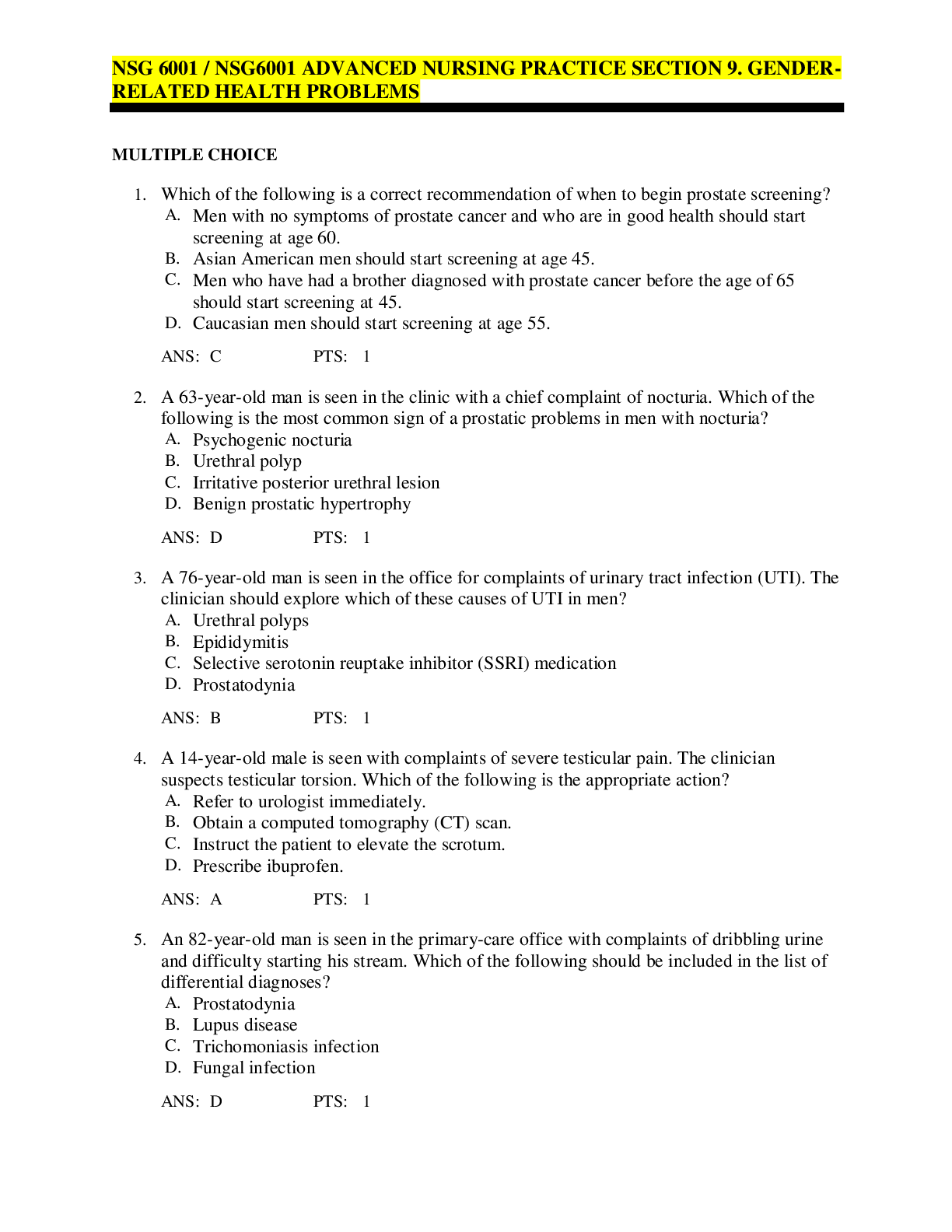
Buy this document to get the full access instantly
Instant Download Access after purchase
Add to cartInstant download
We Accept:

Reviews( 0 )
$12.00
Document information
Connected school, study & course
About the document
Uploaded On
Dec 16, 2020
Number of pages
12
Written in
Additional information
This document has been written for:
Uploaded
Dec 16, 2020
Downloads
0
Views
32

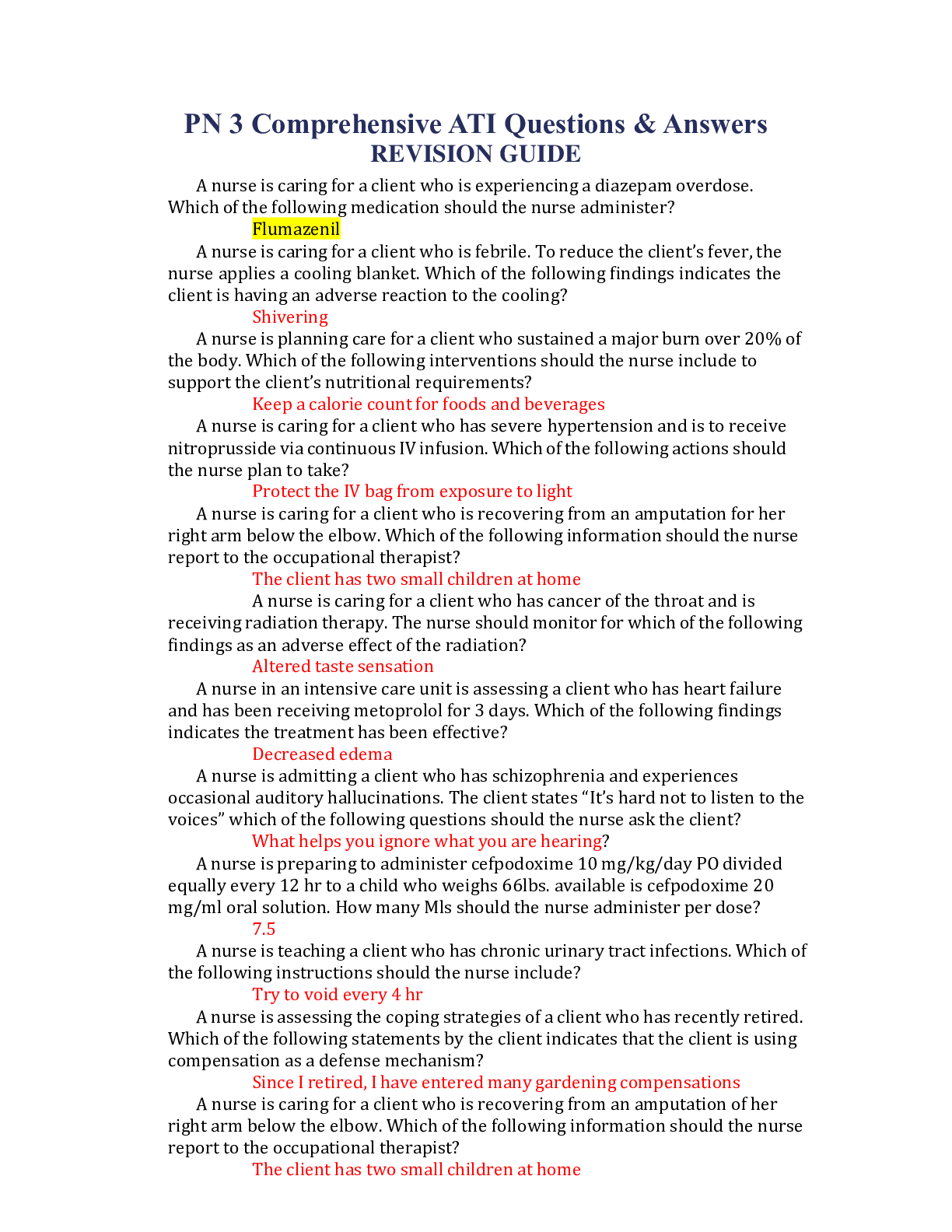
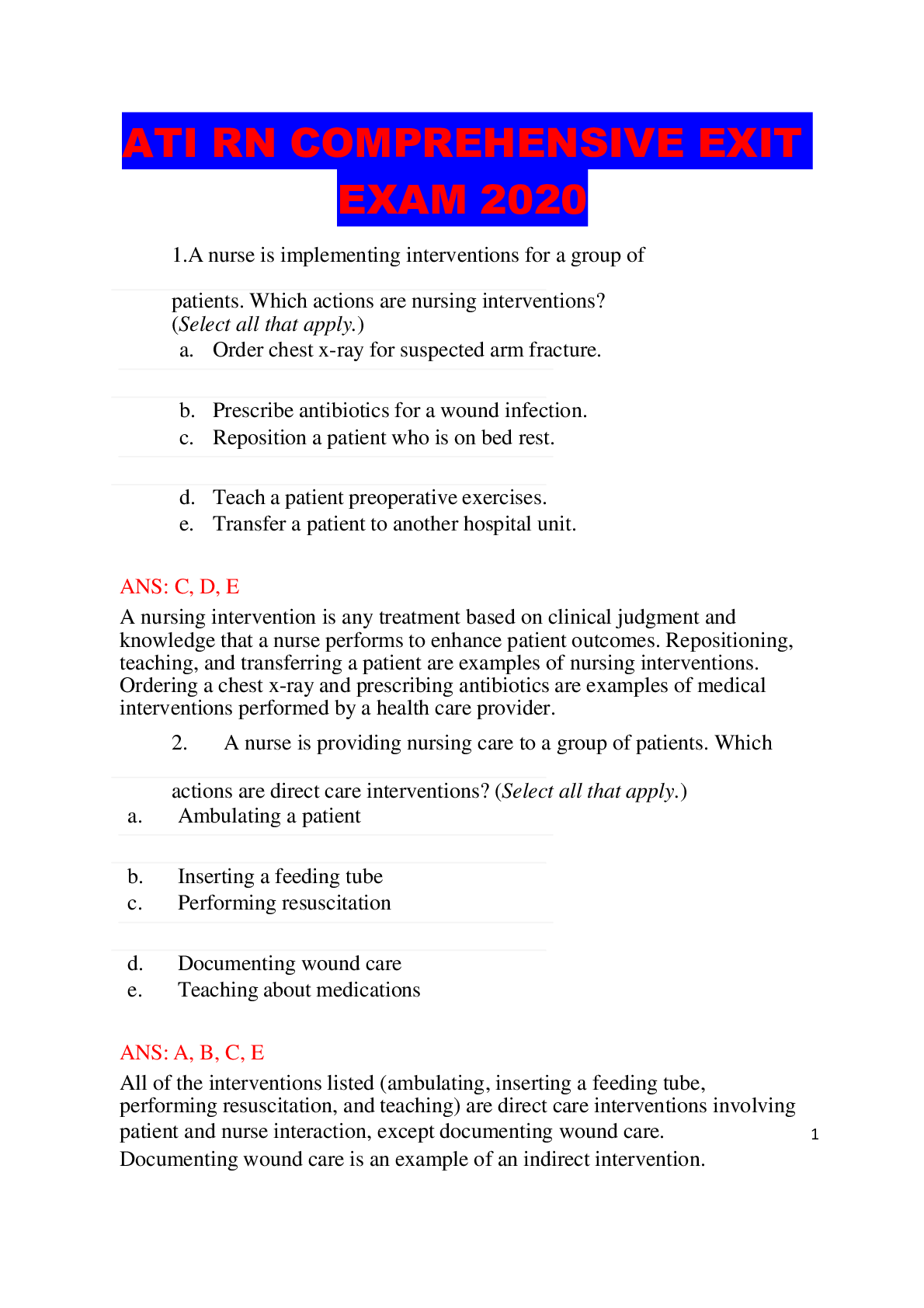


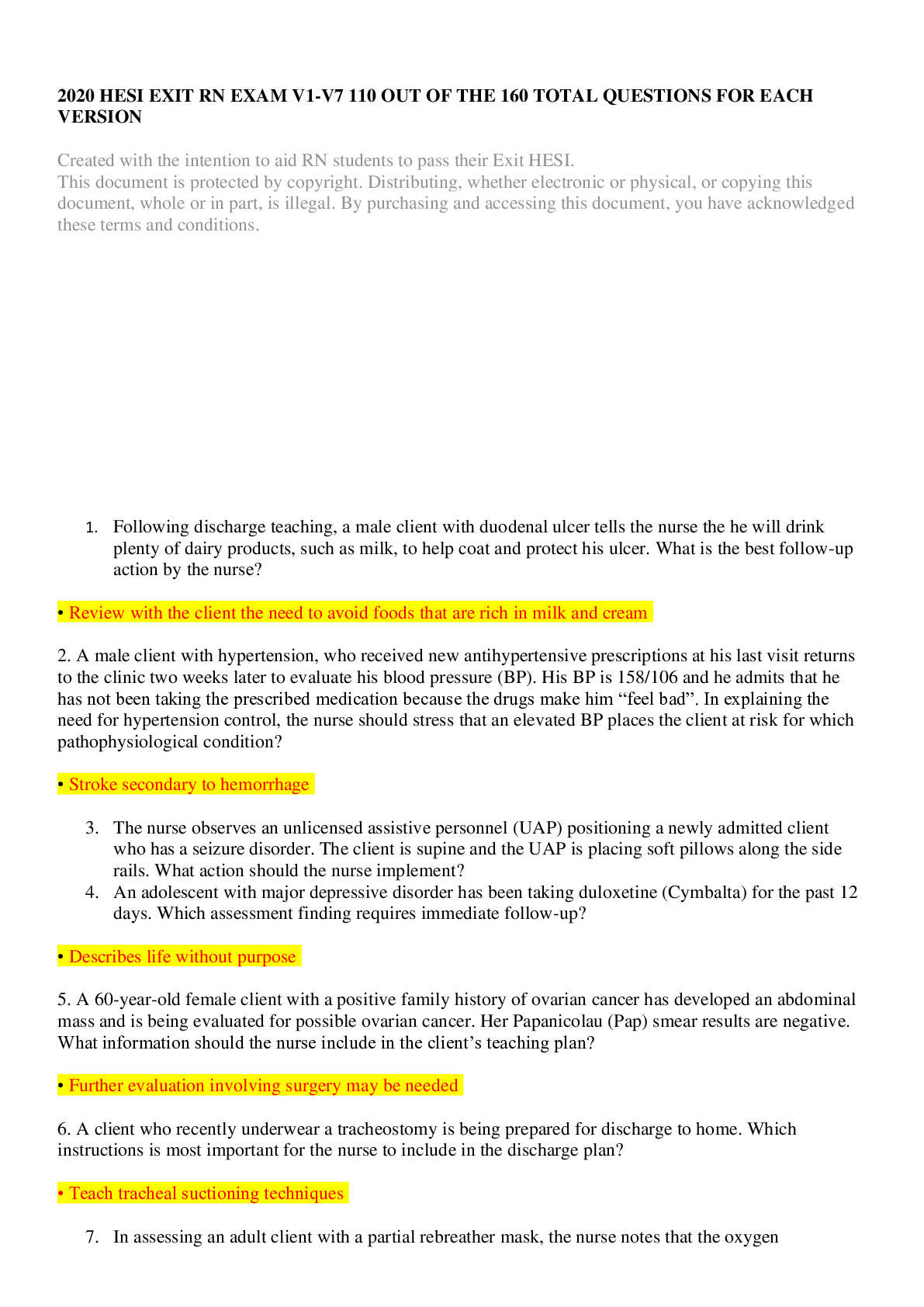


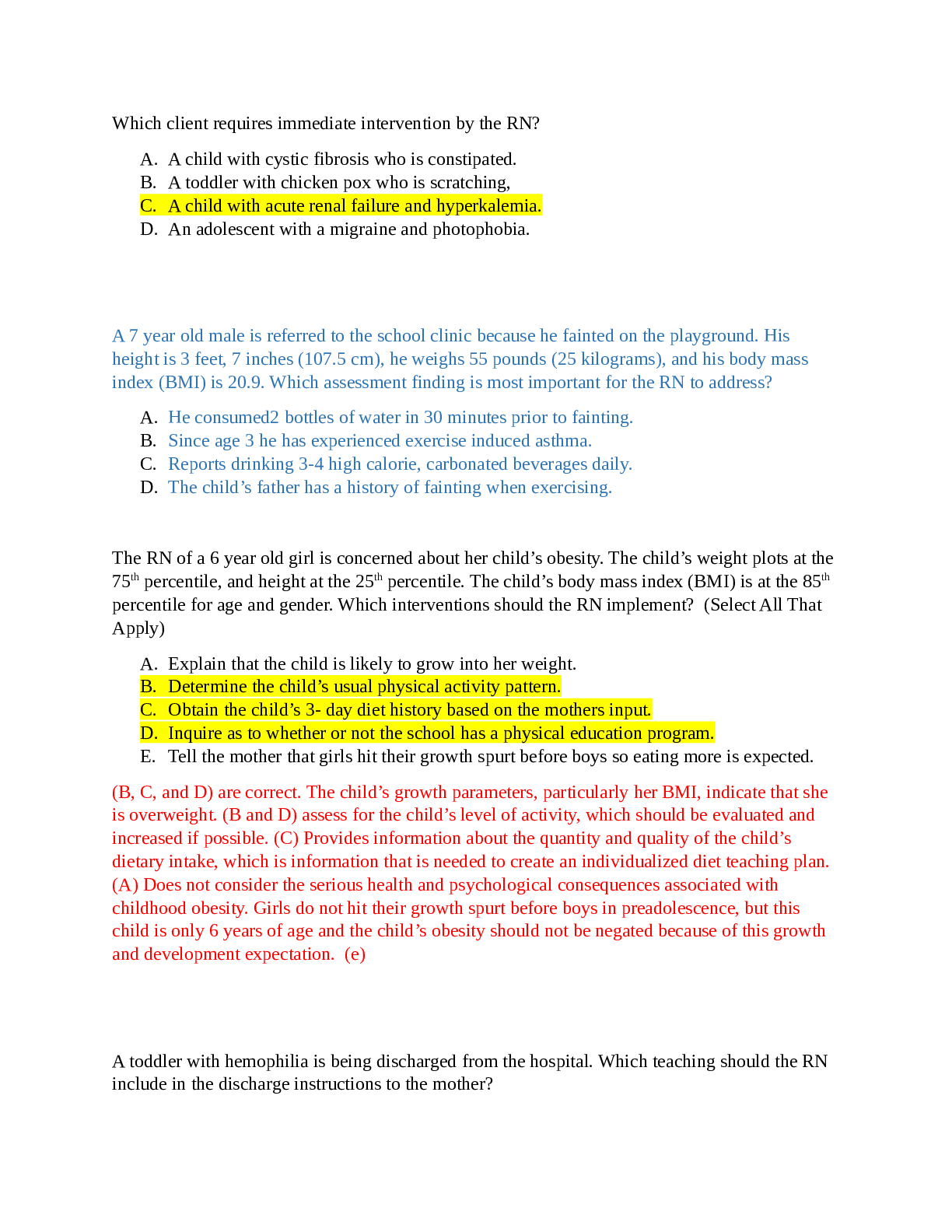
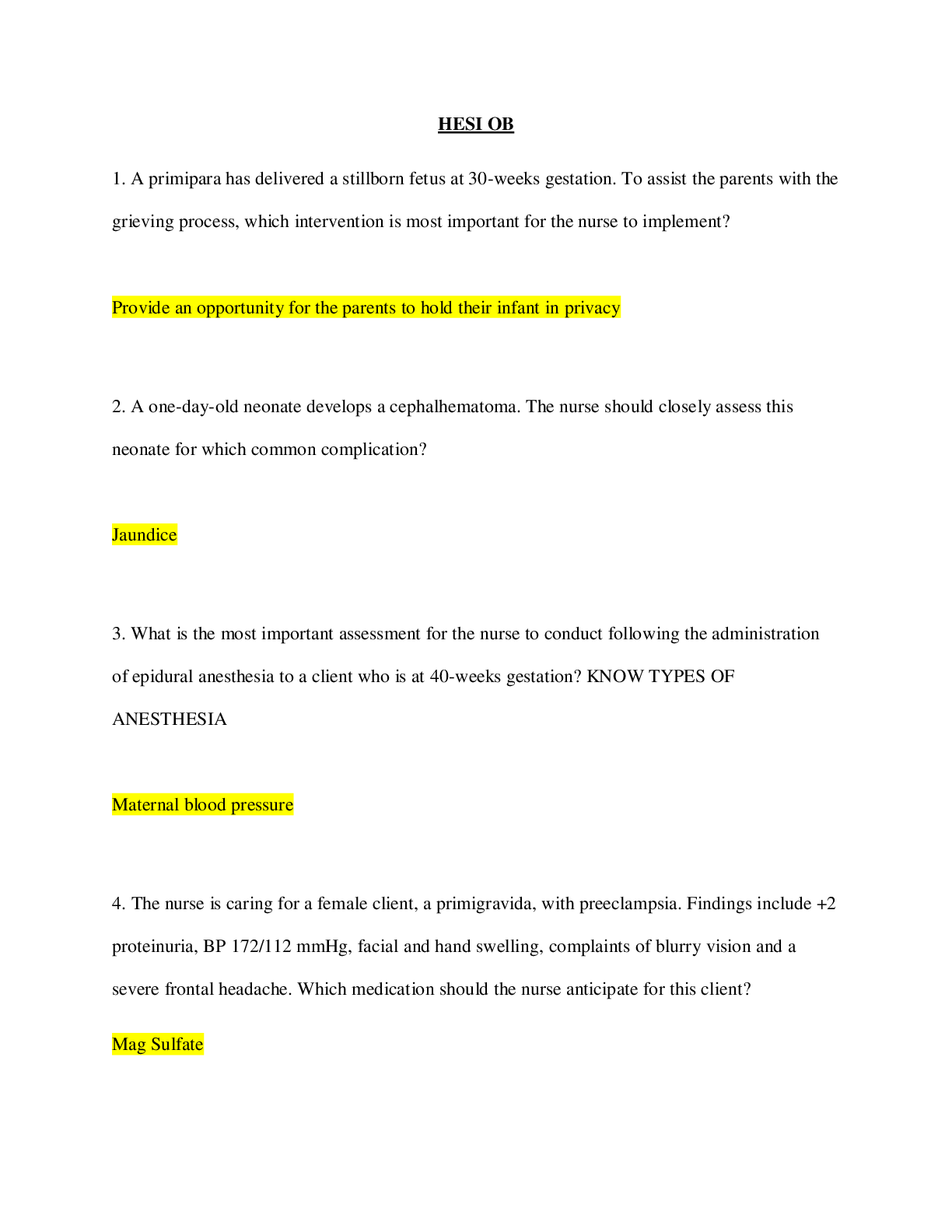
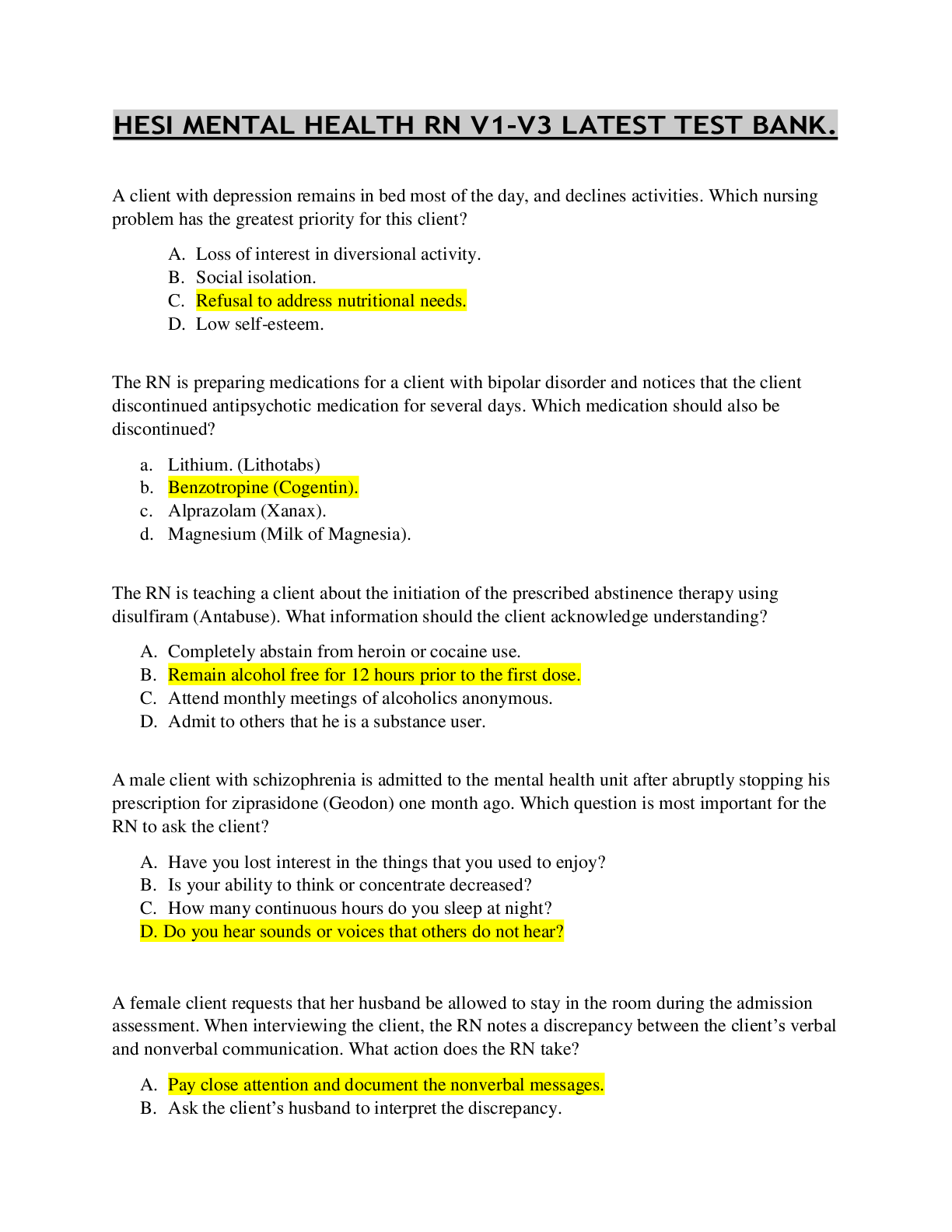


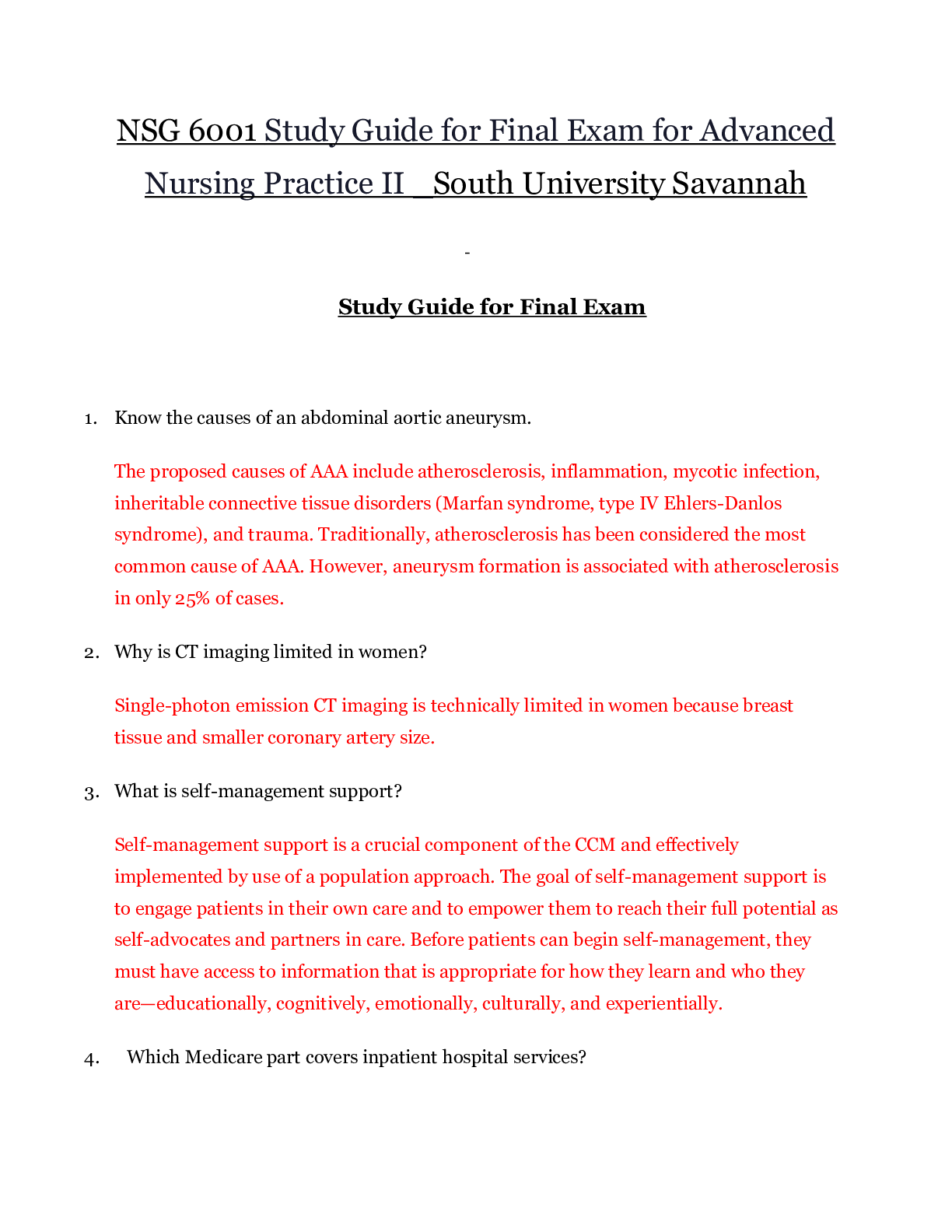

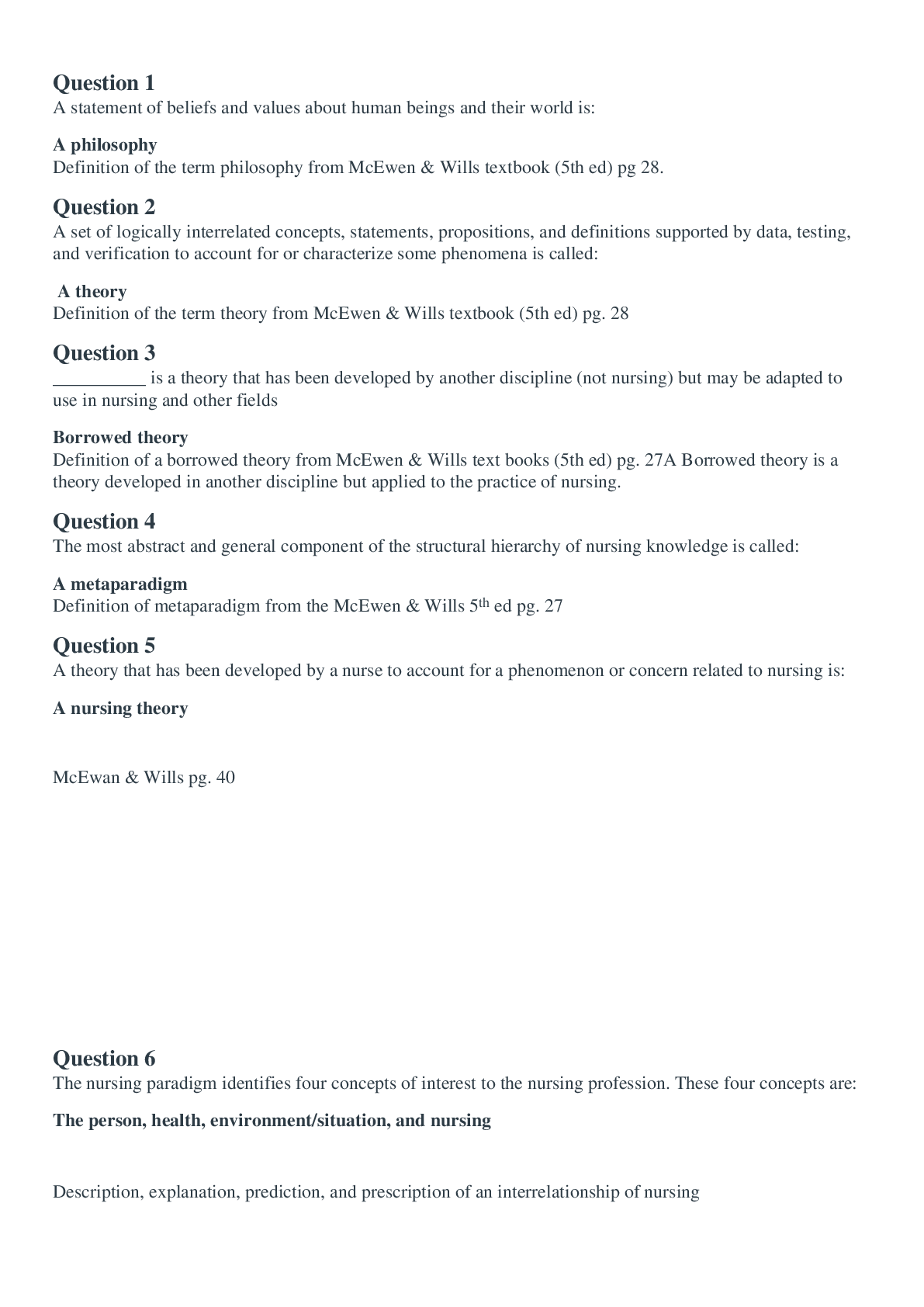



.png)
